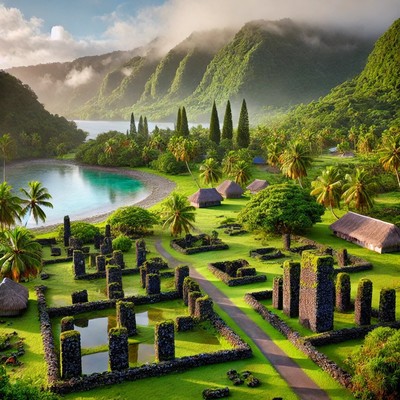Micronesia
TOUR IN
$4400
per person
Availability: 10 places
This Tour Has Been Planned But Dates Are Not Yet Definite And Due To Remote Location. Itinerary Is Subject To Change . The Itinerary Can Also Be Personalized And Tailored To A Small Group. DO NOT BOOK NOW .CONTACT US DIRECTLY travel@
The travelogue delves into the traditions of the islanders, exploring their intricate navigation techniques, local delicacies, and warm hospitality. Encounters with manta rays in Yap, breathtaking atolls in Kosrae, and hidden WWII wrecks in Palau highlight the region’s stunning diversity. Along the way, the author reflects on the balance between modernization and preservation, offering insights into Micronesia’s unique way of life.
Through vivid descriptions and personal experiences, this travelogue paints a picture of a paradise where adventure, history, and culture intertwine, inspiring travelers to explore one of the Pacific’s best-kept secrets.
Day 1
Palikir
Palikir, the capital of the Federated States of Micronesia (FSM), is a small, administrative city on the island of Pohnpei. While it is not a major tourist destination itself, there are several interesting things to explore in and around the area:
Things to Do in Palikir & Nearby Pohnpei
1. Visit the National Government Complex
- As the capital of FSM, Palikir is home to the Congress and Presidential Offices.
- If you're interested in politics or governance, you can explore the administrative buildings and learn about the country's history and leadership.
2. Explore Pohnpei’s Cultural and Historical Sites
- Nan Madol – Located about an hour from Palikir, this UNESCO World Heritage Site is a breathtaking ancient city built on artificial islets. It’s often called the "Venice of the Pacific."
- Spanish Wall – A historic remnant from the colonial era, located in Kolonia (about 10 km from Palikir).
- Sokehs Rock – A towering volcanic formation that offers stunning panoramic views after a rewarding hike.
3. Enjoy Pohnpei’s Natural Beauty
- Kepirohi Waterfall – A picturesque waterfall, perfect for a refreshing swim.
- Pilen Waterfall – A hidden gem with serene jungle surroundings.
- Pohnpei’s Rainforests – Home to unique bird species and lush tropical flora.
4. Surfing and Watersports
- P-Pass (Palikir Pass) – One of the best surf breaks in the Pacific, drawing surfers from around the world for its consistent, powerful waves.
- Diving & Snorkeling – While Palikir itself doesn’t have dive sites, nearby Kolonia and Ant Atoll offer pristine reefs, manta rays, and shipwreck diving.
5. Experience Local Culture
- Markets & Handicrafts – Visit Kolonia’s markets for locally made lava-lavas (sarongs), wooden carvings, and woven baskets.
- Traditional Sakau Ceremony – Try Sakau (kava), a traditional drink made from the Piper methysticum root, known for its calming effects.
Though Palikir itself is more of an administrative hub, its location on Pohnpei provides access to incredible cultural and natural attractions, making it a great base for exploration!
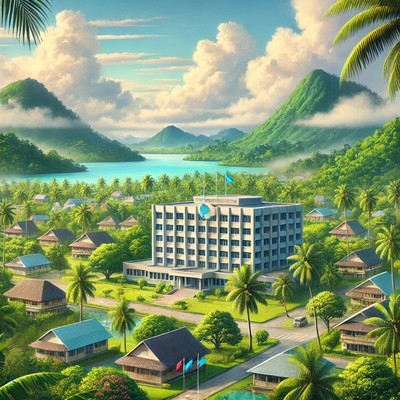
Day 2
Pohnpei
Pohnpei, the largest island in the Federated States of Micronesia (FSM), is a paradise for history buffs, adventurers, and nature lovers. Known for its lush rainforests, ancient ruins, stunning waterfalls, and world-class surfing, there’s plenty to explore.
Top Things to Do in Pohnpei
1. Explore the Ancient Ruins of Nan Madol (UNESCO World Heritage Site)
- One of the most mysterious archaeological sites in the Pacific, often called the "Venice of the Pacific."
- A series of 92 artificial islets built from massive basalt stones, dating back to 500 AD.
- Best visited by boat or kayak, especially at high tide.
2. Hike to Sokehs Rock
- A dramatic basalt cliff offering one of the best panoramic views of Pohnpei.
- The challenging hike takes about 1-2 hours but is well worth it for the scenery.
- You’ll see WWII relics along the way, including Japanese gun emplacements.
3. Chase Waterfalls
Pohnpei is known for its many waterfalls hidden in the jungle:
- Kepirohi Waterfall – The most famous and accessible, great for swimming.
- Liduduhniap Waterfalls – A twin waterfall with natural pools.
- Pahnsile Waterfall – Requires a short but scenic jungle trek.
4. Go Surfing at Palikir Pass (P-Pass)
- One of the best reef breaks in the world, drawing professional surfers.
- Waves can reach 10-15 feet during peak season (October – April).
- Best for experienced surfers, but there are smaller waves for beginners.
5. Scuba Diving & Snorkeling
- Manta Road – A top diving site where you can see manta rays year-round.
- Ant Atoll – A pristine atoll with turquoise waters, coral reefs, and sharks.
- Pakin Atoll – Lesser known, but offers beautiful coral gardens and marine life.
6. Experience Local Culture
- Try Sakau (Kava) – A traditional drink made from the Piper methysticum root, known for its relaxing effects. The best place to try it is in a local village.
- Visit Local Markets – Find handwoven baskets, wooden carvings, and traditional textiles.
- Attend a Cultural Dance Performance – Traditional Chuukese and Pohnpeian dances showcase the island’s heritage.
7. Explore WWII Relics
- Japanese War Ruins – Pohnpei was a Japanese military base during WWII, and you can still see gun emplacements, bunkers, and relics around Sokehs Ridge and Kolonia.
8. Take a Boat Trip to Black Coral Island
- A tiny, secluded island with crystal-clear waters perfect for snorkeling.
- Great for a picnic and relaxing beach day.
9. Visit Kolonia Town
- The main town on the island, featuring small shops, local markets, and historical sites.
- Check out the Spanish Wall, a remnant from Pohnpei’s colonial past.
- Visit the Catholic Bell Tower, a historic structure from the Spanish era.
10. Go Kayaking Through the Mangroves
- Pohnpei has extensive mangrove forests that are best explored by kayak.
- You can spot colorful birds, crabs, and even small sharks in the shallow waters.
Best Time to Visit Pohnpei
- Surfing season: October – April (biggest waves at P-Pass).
- Dry season: December – April (less rain, easier for hiking and sightseeing).
Pohnpei is a hidden gem in the Pacific, offering a mix of adventure, history, and culture. Whether you're into hiking, diving, or just relaxing in nature, there’s something for everyone!
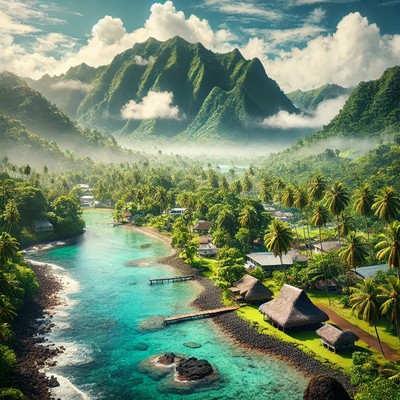
Day 3
Chuuk Lagoon
Chuuk Lagoon, often called the "Wreck Diving Capital of the World," is a must-visit for history buffs, divers, and adventurers. This massive lagoon in the Federated States of Micronesia is best known for its incredible WWII shipwrecks, but it also offers stunning natural beauty and cultural experiences.
1. Scuba Dive the WWII Shipwrecks (Truk Lagoon Wrecks)
Chuuk Lagoon was a major Japanese naval base during WWII. In 1944, the U.S. launched Operation Hailstone, sinking over 60 warships and 250 aircraft, making this one of the best wreck diving sites in the world.
- Fujikawa Maru – A sunken aircraft transport ship with fighter planes still inside.
- San Francisco Maru – Known as the "Million Dollar Wreck," with tanks, mines, and artillery.
- Shinkoku Maru – A former oil tanker with stunning coral growth and marine life.
- Heian Maru – The largest wreck in the lagoon, once a passenger liner turned submarine tender.
- Hoki Maru – Contains military vehicles, including trucks still in its cargo hold.
👉 Most wrecks are shallow enough for recreational divers, but there are also deep technical dives for advanced divers.
2. Snorkeling Around the Wrecks
- Even if you don’t dive, you can snorkel above some of the shallower wrecks and see remnants of WWII history underwater.
- Some of the reefs around Eten Island and Uman Island also offer beautiful coral gardens.
3. Explore the Chuuk Islands & WWII Relics on Land
- Tonowas (Dublon Island) – Once the Japanese headquarters, now has WWII bunkers, command centers, and old airstrips.
- Eten Island – Used as a Japanese airbase, now home to abandoned runways and plane wrecks.
- Fefan Island – Visit local villages and see Japanese gun emplacements.
- Weno Island – The main island of Chuuk, home to markets, resorts, and the Truk Stop Hotel (a hub for divers).
4. Take a Boat Tour Around the Lagoon
- The scenic atolls and islands of Chuuk Lagoon are beautiful, with turquoise waters, lush jungles, and hidden beaches.
- Udot and Tonoas Islands are great for exploring and meeting friendly locals.
5. Visit the Blue Lagoon Resort
- The best place to stay in Chuuk, offering waterfront views, diving tours, and kayak rentals.
- A great place to relax after a long day of exploring.
6. Experience Chuukese Culture
- Visit local villages on smaller islands to see traditional weaving, fishing techniques, and dances.
- Try local cuisine, including taro, breadfruit, and fresh seafood.
- Learn about Chuukese navigation, an ancient skill used to sail the Pacific without modern tools.
7. Kayaking & Paddleboarding
- Explore the mangrove forests and crystal-clear waters around the islands.
- Some resorts rent kayaks for exploring nearby beaches and coves.
Best Time to Visit Chuuk Lagoon
- Dry Season: December – April (best weather for diving & exploring).
- Diving Conditions: Great year-round, but visibility is best from January to March.
Who Should Visit Chuuk Lagoon?
- Scuba Divers & Wreck Enthusiasts – One of the top wreck diving destinations in the world.
- History Buffs – WWII history is everywhere, both underwater and on land.
- Adventure Seekers – Remote, unspoiled beauty with hidden jungles and islands.
- Cultural Explorers – Authentic Micronesian traditions and friendly locals.
Chuuk Lagoon is a dream destination for those seeking history, adventure, and natural beauty. Whether you’re diving into the past or exploring the untouched islands, it’s an unforgettable experience!
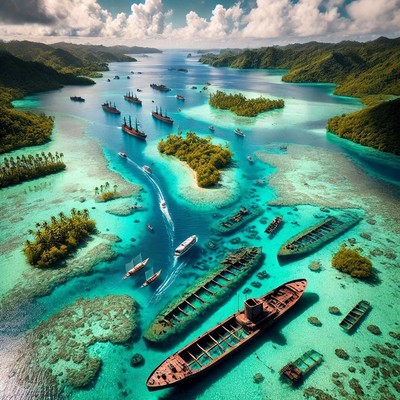
Day 4
Yap
Yap is one of the most traditional and culturally rich islands in Micronesia. Known for its giant stone money, manta rays, and strong indigenous heritage, Yap offers a mix of adventure, history, and cultural experiences.
1. See Yap’s Famous Stone Money (Rai Stones) 🪨
- Yap is home to the world’s most unique currency—massive stone disks (some over 12 feet wide and weighing several tons).
- Visit the Stone Money Banks in villages like Gachpar, Balabat, and Dugor to see how this currency is still used in traditional transactions.
- Learn about the incredible canoe voyages Yapese sailors took to Palau to quarry and transport the stones.
2. Dive with Manta Rays (One of the Best Places in the World!) 🐠
- Yap is world-famous for its manta ray population.
- M’il Channel and Valley of the Rays – Top diving sites where you can see giant manta rays gliding through cleaning stations.
- Great diving year-round, but the best manta encounters are from December to April.
3. Explore Traditional Yapese Culture 🏝️
- Village Visits – Yap has one of the best-preserved cultures in the Pacific, with traditional thatched houses, men's meeting houses ("Faluw"), and ancient pathways.
- Traditional Dancing – Watch colorful performances, often featuring warriors, storytelling, and elaborate costumes.
- Local Weaving & Handicrafts – Yapese people are skilled in weaving grass skirts, baskets, and lava-lavas (sarongs).
4. Snorkeling & Kayaking in the Reefs 🌊
- Yap’s reefs are teeming with coral, reef sharks, turtles, and tropical fish.
- Kayaking through mangroves is a peaceful way to explore the island’s natural beauty.
5. Walk Yap’s Ancient Stone Paths 🚶
- Yap has an ancient network of stone-paved footpaths connecting villages.
- These paths were used for centuries and are still intact today.
- Best trails:
- Colonia to Balabat Path (great mix of history and nature).
- Bechiyal Cultural Center Path (learn about Yapese traditions).
6. Visit the Bechiyal Cultural Center 🏛️
- A great place to learn about Yap’s history, traditions, and way of life.
- Features canoes, traditional houses, and exhibits on navigation techniques.
7. Discover WWII Relics 🔍
- Yap was occupied by the Japanese during WWII, leaving behind relics like:
- Japanese Zero fighter planes hidden in the jungle.
- Gun emplacements and bunkers along the coast.
- Airfields and tunnels used during the war.
8. Relax at Yap’s Resorts & Beaches 🏖️
- Manta Ray Bay Resort – The top resort for divers, featuring an onboard brewery and ocean-view rooms.
- Sunset Park Beach – A peaceful place to relax and watch the sunset.
- O’Keefe’s Waterfront Inn – A historic boutique hotel in Colonia, the main town.
9. Experience Traditional Sailing & Canoe Building ⛵
- Yapese sailors are legendary for navigating the Pacific without modern instruments.
- Some villages still build and sail traditional outrigger canoes.
- You can even take a ride on a traditional canoe if you visit the right village!
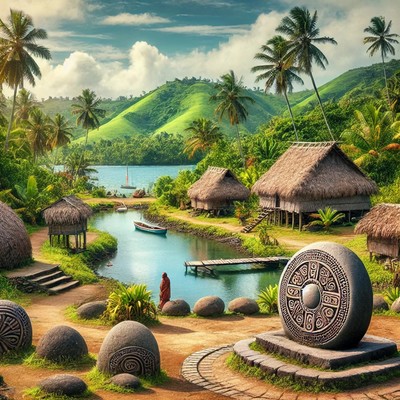
Day 5
Kosrae
Kosrae, known as the "Jewel of Micronesia," is one of the most untouched and pristine islands in the Pacific. With lush jungles, ancient ruins, spectacular diving, and a rich cultural heritage, it’s a paradise for nature lovers and adventurers.
1. Explore the Ancient Lelu Ruins 🏛️
- One of Micronesia’s most significant archaeological sites, dating back to the 13th century.
- Massive basalt walls, tombs, and royal residences from the ancient Kosraean kingdom.
- Located near Lelu Village, easily accessible.
2. Go Scuba Diving & Snorkeling in Pristine Coral Reefs 🐠
Kosrae has some of the healthiest coral reefs in the world! Top dive sites include:
- Hiroshi Point – Best for snorkeling, with colorful reef fish and coral gardens.
- Blue Hole – A unique underwater sinkhole teeming with marine life.
- Shark Island – A dive site where you can see reef sharks, rays, and turtles.
- Walung Drop-Off – A dramatic coral wall dive with vibrant marine biodiversity.
👉 Best diving visibility: November – May.
3. Hike to Mt. Finkol (The Highest Point on Kosrae) ⛰️
- A challenging jungle trek up 634 meters (2,080 ft), offering stunning panoramic views.
- See rare orchids, tropical birds, and waterfalls along the way.
- Best for experienced hikers (muddy and steep in some areas).
4. Visit the Menke Ruins (Lost Jungle Temples) 🏚️
- Hidden deep in the rainforest, these ruins are believed to be over 1,000 years old.
- Possibly used as a sacred religious site by Kosrae’s early settlers.
- Accessible via a guided jungle trek.
5. Kayak Through the Mangrove Forests 🛶
- Kosrae has extensive mangrove channels perfect for kayaking.
- Spot exotic birds, crabs, and small sharks in the shallow waters.
- Best areas: Utwe-Walung Marine Park & Okat Mangroves.
6. Relax on Kosrae’s Secluded Beaches 🏝️
Kosrae isn’t known for typical white-sand beaches, but it does have stunning, quiet shorelines:
- James Palsis Marine Park – A hidden gem with clear waters and picnic spots.
- Walung Beach – A remote, peaceful beach with no crowds.
- Tafunsak Beach – Great for sunset views.
7. Learn About Kosrae’s Culture 🌺
- Visit a local village and see traditional weaving, carving, and farming.
- Try Kosraean cuisine – featuring fresh fish, breadfruit, taro, and coconut-based dishes.
- Attend a traditional song and dance performance if you visit during a local festival.
8. Explore WWII Relics 🔍
- Kosrae was a Japanese outpost during WWII, and remnants still exist:
- Japanese caves and tunnels in the jungles.
- Abandoned gun emplacements and bunkers.
- A shipwreck off Lelu Harbor (accessible via dive or snorkel).
9. Visit the Kosrae Island Museum 🏛️
- A small but interesting collection of ancient artifacts, photographs, and traditional tools.
- Great place to learn about Kosrae’s history, culture, and unique stone money traditions.
10. Take a Boat Trip to Walung Village 🚤
- One of the most traditional villages on Kosrae, only accessible by boat.
- Experience local life, meet friendly villagers, and see ancient canoe houses.
- Stunning lagoon views along the way!
Best Time to Visit Kosrae
- Dry Season: December – April (best for hiking and diving).
- Rainy Season: May – November (lushest landscapes, but more rain).
Who Should Visit Kosrae?
✅ Scuba Divers & Snorkelers – Some of the healthiest reefs in the world.
✅ Adventure Seekers – Jungle hikes, ancient ruins, and mangrove kayaking.
✅ History & Culture Enthusiasts – Ancient cities, WWII relics, and traditional Kosraean customs.
✅ Eco-Travelers – A pristine, uncrowded paradise with sustainable tourism.
Kosrae is a hidden gem in Micronesia, perfect for travelers looking for untouched nature, rich history, and genuine cultural experiences. If you love off-the-beaten-path adventures, this is the island for you!
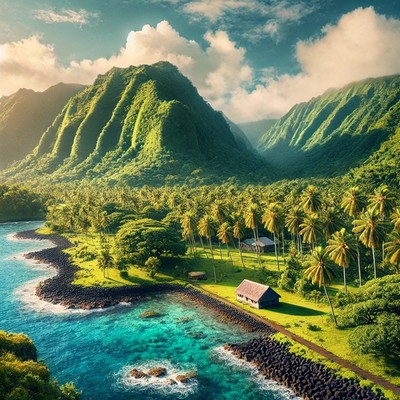
Day 6
Lelu
Lelu is one of the most historically and culturally rich areas of Kosrae, known for its ancient ruins, pristine nature, and charming village atmosphere. Whether you're into history, adventure, or relaxation, Lelu has plenty to offer.
1. Explore the Ancient Lelu Ruins 🏛️
- One of the most important archaeological sites in Micronesia, dating back to 13th-15th century.
- Features massive basalt stone walls, royal tombs, and the remains of an ancient city once ruled by Kosraean kings.
- Similar to Nan Madol in Pohnpei but easier to explore on foot.
- Overgrown with lush greenery and moss, giving it a mysterious, lost-world feel.
👉 Tip: Hire a local guide to learn about the history and legends of the ruins.
2. Snorkeling & Diving in Lelu Harbor 🐠
- Lelu Harbor offers calm, clear waters with coral reefs, tropical fish, and occasional sea turtles.
- Great snorkeling spots are near Lelu Wharf and the nearby Blue Hole.
- Scuba divers can explore WWII shipwrecks and sunken artifacts in the area.
3. Hike to Mount Finkol (Kosrae’s Highest Peak) ⛰️
- Located near Lelu, this 634-meter (2,080 ft) mountain offers stunning panoramic views of Kosrae.
- The hike is challenging but takes you through lush rainforests filled with exotic plants and birds.
- Best for adventurous travelers looking for an off-the-beaten-path experience.
4. Visit Lelu Island’s Villages & Experience Local Culture 🌺
- Lelu is home to friendly locals and well-preserved Kosraean traditions.
- Visit a traditional Kosraean home and learn about local customs.
- See artisans weaving baskets, mats, and wooden carvings.
- Try Kosraean cuisine, which includes fresh fish, taro, breadfruit, and coconut-based dishes.
👉 Tip: If visiting during a festival, you may get to see traditional dancing and music performances!
5. Kayak Through the Mangroves 🛶
- The mangrove channels around Lelu are perfect for a quiet kayak or canoe trip.
- Spot colorful birds, crabs, and even small sharks in the shallow waters.
- The best routes start near Utwe-Walung Marine Park, just a short trip from Lelu.
6. Visit Lelu’s WWII Relics 🔍
- During WWII, Kosrae was occupied by Japan, leaving behind historical sites:
- Gun emplacements and bunkers hidden in the jungle.
- A sunken shipwreck near Lelu Harbor, visible to divers and snorkelers.
7. Relax at Lelu’s Beaches & Waterfront Areas 🏖️
- While Kosrae is not known for long white-sand beaches, you can still enjoy peaceful coastal views and clear waters near Lelu.
- James Palsis Marine Park is a great place to relax with picnic spots and snorkel-friendly waters.
8. Take a Boat Trip Around Kosrae’s Coastline 🚤
- Lelu’s location makes it a great starting point for boat tours around Kosrae.
- Visit Walung Beach, one of the most remote and pristine beaches on the island.
- Explore hidden coral reefs and small uninhabited islands.
Best Time to Visit Lelu, Kosrae
- Dry Season: December – April (best for hiking, diving, and sightseeing).
- Rainy Season: May – November (lush landscapes, but frequent rain).
Who Should Visit Lelu?
✅ History Buffs – The Lelu Ruins and WWII relics make this a must-visit for anyone interested in the past.
✅ Nature Lovers – With rainforests, mangroves, and reefs, Lelu is perfect for eco-travelers.
✅ Adventure Seekers – Hiking, snorkeling, and kayaking opportunities abound.
✅ Cultural Travelers – Experience authentic Kosraean traditions and hospitality.
Lelu is a hidden gem on Kosrae, offering a perfect blend of history, nature, and local culture. Whether you want to explore ancient ruins, dive into clear waters, or simply relax in a quiet paradise, Lelu has something for everyone!
